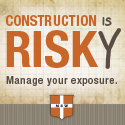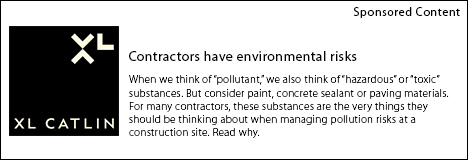BY MARK J. TROXELL, VICE PRESIDENT OF SAFETY SERVICES, THE GRAHAM COMPANY
SHANE RICCIO, PRODUCER, THE GRAHAM COMPANY
As many of you can attest, the economic recovery has continued to keep backlogs flush, but that has only heightened the need to find and retain skilled workers. The construction industry has some unique challenges in finding and retaining enough qualified candidates to fill all available positions. If you’re fortunate to find a skilled candidate, the process cannot stop there. After hiring, it is important that you have a structured onboarding process to train new people on safe work practices for the types of hazards they will encounter on the project and to properly acclimate them to the desired safety culture. This is the only way to keep a safety culture intact.
A new hire’s first impression of a company can set the stage for the rest of their employment. A company with a structured, well-executed onboarding program conveys it is well- run, values its employees, and expects its employees to work safely as a condition of employment. A company that lacks or has a poorly structured onboarding program conveys it is disorganized and indifferent to employee safety.
As backlogs boom, maintaining a successful onboarding process is increasingly critical to not only efficiently complete projects, but also manage risk. The most effective programs will:
HIRE THE RIGHT PEOPLE
It is often said that people are our greatest asset. Let’s take that a step further because it is more than just hiring people. It is about hiring and retaining the right people that are physically capable of performing tasks on a continuous basis, placing those people in the proper position within your organization, training them to perform assigned tasks safely, and motivating them to be successful.
The Construction Industry Institute (CII) reports that "contractors with employee retention rates of 80 percent or higher realize increased job profits, complete more projects on time or ahead of schedule, and have better project safety performance."
ESTABLISH GOALS & EXPECTATIONS
It is important to discuss company values and goals with each new hire to establish expectations for continued employment. Our most successful clients have safety as a core value. When you review core values, emphasize the company’s commitment to a safe work environment and expectations regarding safety — this sends a powerful message to any new hire.
Managers should take the time to meet weekly with new employees during their probationary period to answer questions and show interest in the new hire’s employment.
REVIEW POLICIES & PROCEDURES
Spend the time to thoroughly review your organization’s policies and procedures. Employees must know company requirements and expectations regarding substance abuse, work hours, appearance, workplace discrimination, treatment of others, employment accountability, etc. Include client expectations in the discussion if a new employee is reporting directly to a job site.
An employee handbook is helpful to a new hire. It provides workplace guidelines and the employee can refer back to it as a resource document. Have the employee sign a document that acknowledges company policies and procedures have been explained to them.
PROVIDE WORKPLACE SAFETY TRAINING
The safety orientation process is the company’s first opportunity to review safety expectations and procedures in detail. The orientation should take place prior to a new employee working on site. The safety orientation should not be rushed; you need to detail behavior expectations, workplace safety requirements, and emergency procedures.
The safety orientation should not be the end of a new hire’s safety training. Employees should receive hazard-specific safety training prior to being asked to perform a task. The hazard safety training must meet OSHA’s requirements, but it is important that the task training include safe work procedures established by the company. The safe work procedures may exceed minimum OSHA requirements.
ASSIGN A MENTOR
It is beneficial to utilize one of your high-performing employees as a mentor. The mentor can help the new hire become comfortable on the job and answer questions. We also recommend that new hires be identified by the color of their hard hats. If a company has a specific color or logo on their hard hat, the new hire has to earn the hard hat with the logo by showing their commitment to safety. We suggest letting the mentor and the manager on site be the judge of the new hire’s commitment to safety.
ESTABLISH A PROBATIONARY PERIOD
If permitted, establish a probationary period. A 90-day probationary period gives both you and the new hire time to see whether or not you’re truly a good fit for each other. Of course, some new hires may not make it through the probationary period. Do not be afraid to terminate employment for cause if you feel the employee is going to injure themselves or others by using unsafe work practices or not showing up to work.
DEVELOP AN ONBOARDING CHECKLIST
Create and maintain a file of a simple checklist to make sure that no steps were missed in the onboarding process.
BENEFIT FROM LOWER PREMIUMS
Hiring the right workers for the right positions at the right times requires consistent attention to all of the above tactics. But it’s a smart investment because by following these protocols, you can cultivate a more skilled workforce that upholds a commitment to safety. As a result, you will reduce the frequency and severity of claims over time and that will ultimately reduce insurance premiums.
Mark J. Troxell, ARM is vice president of safety services at The Graham Company, a member of multiple AGC chapters. With over 28 years of safety and loss control experience, Mark is responsible for overall direction of the firm’s Safety Division and providing safety consultation to construction and maritime clients. He can be reached at mtroxell@grahamco.com. Follow Graham on Twitter @TheGrahamCo or follow the firm’s Risk Matters blog for the latest insights.
Shane Riccio is a producer at The Graham Company. As a producer, Riccio focuses on business development for the firm’s Construction Division. He specializes in creating risk management programs for large privately held companies with complex operations and demanding insurance needs. He can reached at sriccio@grahamco.com. Follow Graham on Twitter @TheGrahamCo or follow the firm’s Risk Matters blog for the latest insights.

 2300 Wilson Boulevard, Suite 300 · Arlington, VA 22201 · 703-548-3118 (phone) · 703-548-3119 (fax) · www.agc.org
2300 Wilson Boulevard, Suite 300 · Arlington, VA 22201 · 703-548-3118 (phone) · 703-548-3119 (fax) · www.agc.org
 AGC Files Suit to Block Obama Administration's Misguided Silica Rule
AGC Files Suit to Block Obama Administration's Misguided Silica Rule


